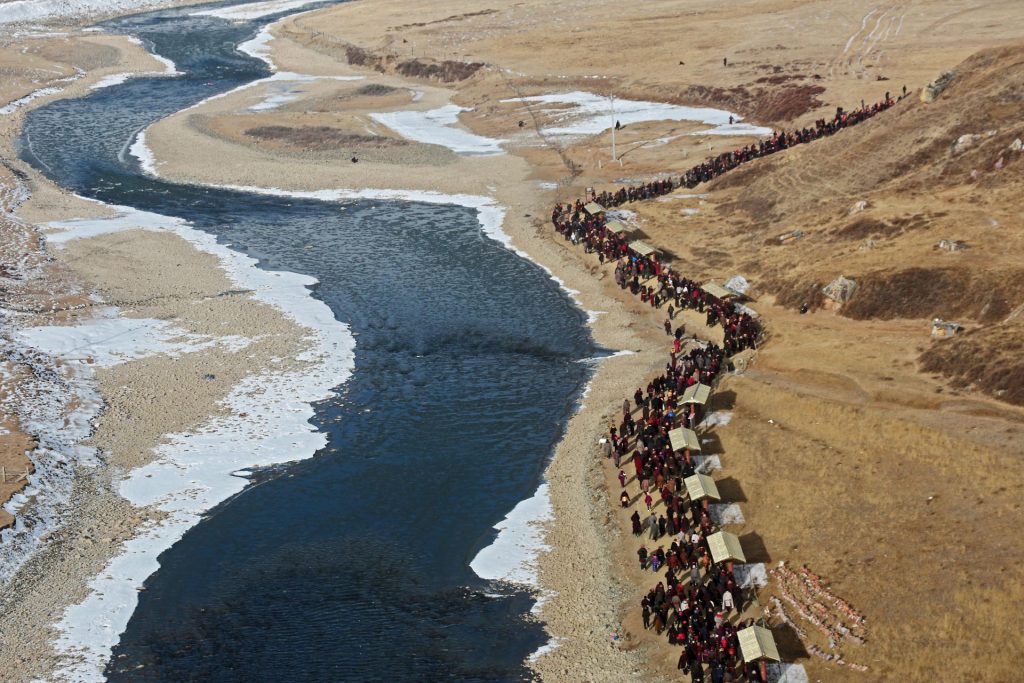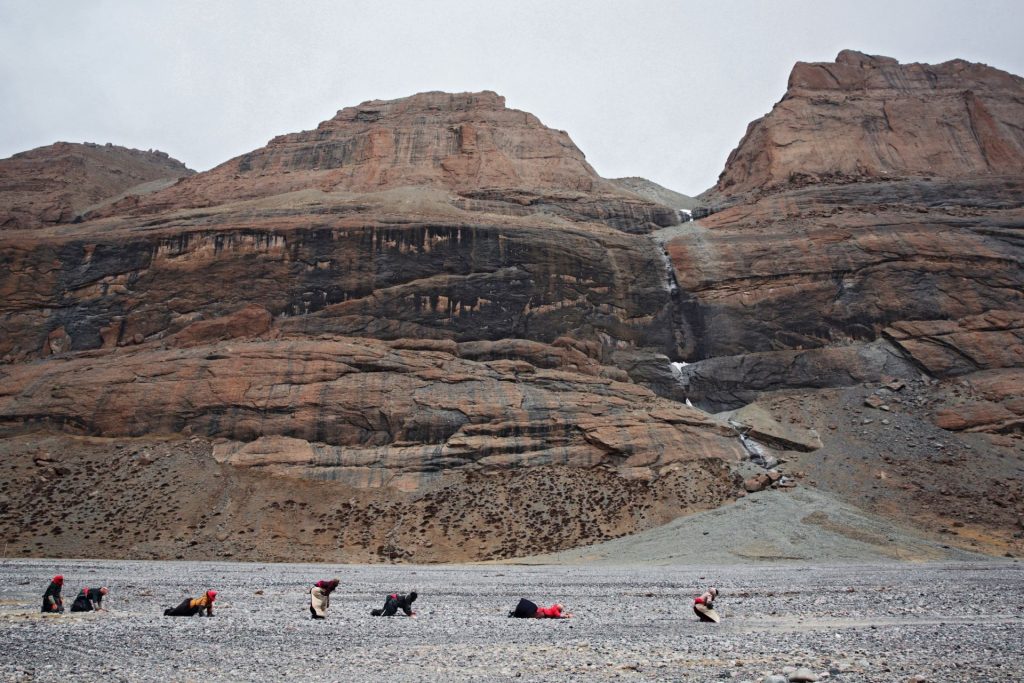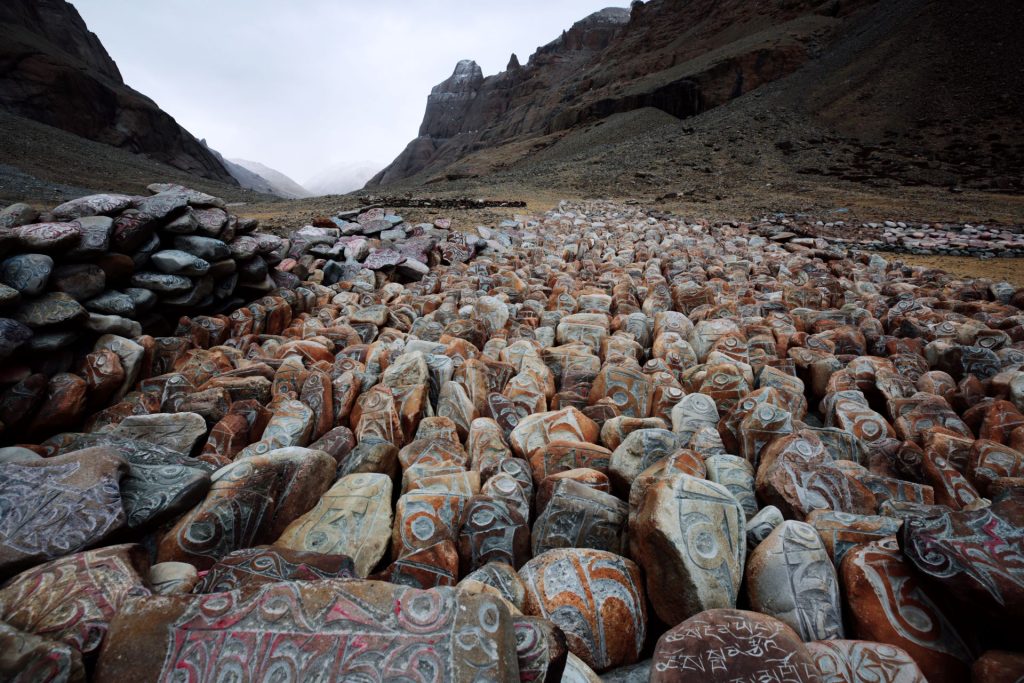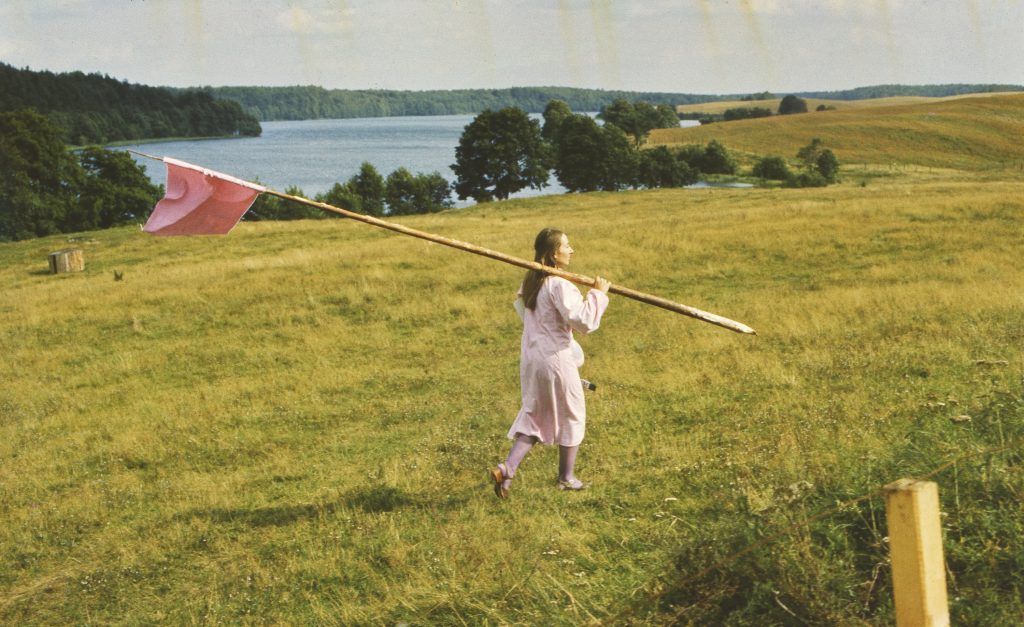Through the Land
A History of Pilgrimage
text: James Harpur
photography: Luo Jian
A pilgrimage is a journey not to be taken lightly. A short history.

In the early 21st century, pilgrimage in the West is enjoying a boom, perhaps more so than at any time since the Middle Ages. Shrines such as Lourdes in France, Santiago de Compostela in Spain, and the basilica of Our Lady of Guadalupe in Mexico receive millions of pilgrims every year. At the heart of this attraction is a spiritual impulse that has existed from time immemorial. It is a desire that connects us with our medieval forebears and, indeed, ancient ancestors, and which in turn will connect us with our descendants. Pilgrims of every era and every faith are bonded by comparable aspirations, hopes, doubts, physical endeavours, rituals, and prayers.
The reasons for pilgrimage are numerous. They include giving thanks to God, fulfilling a vow, petitioning a holy figure for a cure, performing a penance, reinvigorating one’s faith, and, more unofficially, experiencing the sights and sounds of the journey. A pilgrimage also traditionally has a number of recognised stages: preparation, including putting one’s affairs in order before departing and acquiring the right travelling clothes and accessories; the journey itself; the arrival, accompanied by sacred rituals (such as saying prayers and lighting a candle); the return journey; and reintegration into the world the pilgrim left behind. It is these stages and rituals that have created a coherent pilgrimage tradition down the ages.
The words ‘pilgrim’ and ‘pilgrimage’ are derived from the Latin peregrinus (from per, ‘through’, and ager, ‘field’ or ‘land’, so ‘pilgrimage’ literally means ‘through the land’), which clearly suggests the idea of a journey and implies a predetermined destination. Yet there were Irish peregrini, i.e., pilgrims, in the early Middle Ages who left their country and set out ‘for the love of Christ’ without a destination.
Even if pilgrimage does not technically need a specific destination, it still implies a physical journey, as well as an accompanying state of serious inner reflection (which some would term ‘religious’ or ‘spiritual’) to distinguish it from mere travel or sightseeing. Pilgrimage, then, may refer to an inner—emotional, mental, and spiritual—journey as well as an outer, physical one. Even so, inner pilgrimage, like its external counterpart, still implies movement—toward a new spiritual state of being. Therefore, whether pilgrimage is made physically or contemplatively, the idea of journeying remains central to it: the pilgrim must make a journey because he or she needs time—time to reflect on personal milestones or conflicts, or upon the great mysteries of life such as love, fate, suffering, and the nature of God. For the pilgrim, the journey, with all its vicissitudes, is not the wearisome preamble to truth; it is the necessary way to truth, the living, arduous, and joyful process by which truth can be attained.
Pilgrimage has inherent challenges, whether embarked on inwardly or outwardly. It is a journey not to be taken lightly: the physical challenges of heat, cold, rain, pain, and fatigue—and likewise interior hardships—can open up the mind to old memories and new possibilities as well as effect an emotional and spiritual purification. What is essential is that the journey, by whatever means it is accomplished, gives the pilgrim enough time to expose himself or herself to the possibility of a sacred metamorphosis. The pilgrim’s final arrival at the shrine, the source of holiness, signifies the soul’s entering a state of blessedness, a rehearsal on earth for what heaven has in store. If that is done, the destination will signify not the end of the journey, but the start: a gateway into a new way of being, of seeing life afresh with spiritually cleansed eyes.
Of course, for the pilgrim—unlike the immortal soul—there is the question of returning, a process of disengaging from the sanctified place and state, from temporary oneness with the divine, and of reintegration with the secular, the familiar world of ‘home’. Yet for those pilgrims who have successfully committed themselves in thought and action to the transformatory journey, their adjustment to the quotidian will be sustained by a renewed attitude toward it, by the knowledge that they have reenacted the journey of the soul and glimpsed the blessed state, even if only in a fragmentary way.
If people did not have a spiritual or religious capacity, the pilgrimage tradition would never have begun; and this belief in a supernatural dimension, as well as the desire to perform rituals to gain divine favour, is probably as old as humankind itself. There is enough evidence to suggest that our prehistoric ancestors performed religious rituals. But did they go on ‘pilgrimage’? Certainly in historical times, when written records were first made, there is material evidence (such as scriptures, artifacts, and the remains of temples and tombs) to indicate that people all over the world, from the ancient Greeks, Romans, and Celts in the West, to the Indians and Chinese in the East, practiced religious rituals that included sacred journeys. A few examples from ancient to contemporary times.

Ancient Times
Wine and Festivals
‘Pilgrimage’ was found not only in ancient Greece and Rome but also Egypt and Phoenicia. The Greek historian Herodotus (in the fifth century BCE), for example, described what appears to be a regular Egyptian spiritual journey to the town of Boubastis, home of the goddess Bastet-Artemis, in the Nile Delta. Herodotus said that travellers of both sexes sailed down the Nile, in various crafts, the joyous atmosphere being whipped up by singing, clapping, and flute playing. The boats would stop at various towns along the way, with the female pilgrims performing traditional rituals at each place, until they reached Boubastis. There they would join in the festivities and sacrifices, ‘and more wine of grapes is consumed upon that festival than during the whole of the rest of the year.’
Middle Ages
All-Inclusive Tours
Medieval pilgrims who travelled by land would proceed on foot, or by horse, donkey, mule, or in a wagon. Each day, pilgrims aimed to arrive at an inn, monastery, or hospice before night fell; otherwise, the sheer intensity of darkness—almost unimaginable now in most parts of the world—coupled with a lack of road signs and maps, and possible robberies, might prove their undoing. There was also danger from wolves and other wild animals. The most convenient way to travel to the Holy Land in the later Middle Ages was in a Venetian ship. In the early thirteenth century, Venice had developed the first pilgrim ‘package tours’ with private shipowners, licensed by the state, providing transport, food, and accommodation for a payment that also included local taxes and guides’ fees.
Reformation
Religious Skepticism
In the West, the great age of medieval pilgrimage ended with the Reformation. The Protestant reformers had no time for relics, nor for purgatory and the cult of the saints. They damaged pilgrimage both by physically destroying shrines and relics and by attacking its underlying theological assumptions. Luther, for example, stated that going on pilgrimage deluded people into believing they were performing important virtuous acts. God, he said, had commanded us to look after our families and neighbours – not to go off to Rome on a spending spree, masking curiosity or ‘devilish delusion’ with piety.

Modern Times
Community and Transport
During the course of the 19th and early 20th centuries, pilgrimage reawakened. The reasons for this development are difficult to establish.Increasing industrialisation and mechanisation of society may have resulted in a longing for rituals that gave sense of communitas. A spur to renewed pilgrimage was transport: steamboats and trains could now cover in days journeys that would have taken weeks to accomplish by sail or on horseback. The 19th century saw the start of ‘package’ vacations, pioneered by Thomas Cook. In 1876, Cook’s Tourists’ Handbook for Palestine and Syria provided essential information for travellers.
Contemporary Times I
Revival
Today, pilgrimage in the Western world is experiencing a revival, perhaps partly boosted by secular activities such as sightseeing and hiking. The numbers of pilgrims’ passports issued at official pilgrim offices along the Camino, for example, have increased steadily: in 1985 several hundreds of people arrived in Santiago; and 1993, a Holy Year, drew almost 100,000 people. From then on numbers have consistently reached five of six figures. In the Holy Year of 2010 more than 270,000 pilgrims made the journey, and last year, there were almost 450,000 pilgrims.
Contemporary Times II
Web Pilgrims
As pilgrimage in the West has developed in modern times, it has broadened its appeal to those who would not count themselves as spiritual seekers participating for the exhilaration of walking and meeting fellow hikers. In addition; the number of destinations grew as secular historic buildings and sites can become sacred and have similar potency as the shrines and relics of the Middle Ages pars, landscapes and gardens, but museums too can attract spiritual travellers. Like medieval cathedral relics, some museum rooms are like private chapels. Perhaps the most radical issue concerning pilgrimage of the 21st century is the possibility that, like shopping, you can do it from your armchair. ‘Virtual pilgrimage’ has been made possible by websites and online maps.
Future
Soul Making
What about the future of pilgrimage? Pilgrimage in the Western world has survived some 2,000 years, and the indications are that it will continue to thrive in the future – if only because pilgrimage relates directly to the human condition, the ‘Vale of Soul Making’ as John Keats called it, it will likely never go out of fashion.
JAMES HARPUR is an award-wining poet and author whose books include: The Pilgrim Journey (BlueBridge, 2016); The Oratory of Light: poems inspired by St Columba and Iona (Wild Goose, 2021); The Gospel of Gargoyle (Eblana Press, 2024); and the forthcoming Dazzling Darkness: The Lives and Afterlives of the Christian Mystics (Hurst, 2025). He lives in West Cork.
LUO JIAN is a photographer based in Paris and Beijing. In his series Deep Red, he captures the spiritual lives and pilgrimages of Tibetan nuns. As Chinese authorities tighten control over Tibet, Tibetan Buddhism – once deeply inter- twined with politics – has become increasingly apolitical. Monastic values such as contentment, humbleness, and forbearance are being overshadowed by enforced political compliance and religious repression. Jian: ‘Today, governed by the red regime, the red religious life is peaceful yet suppressed, silent yet subservient.’




















